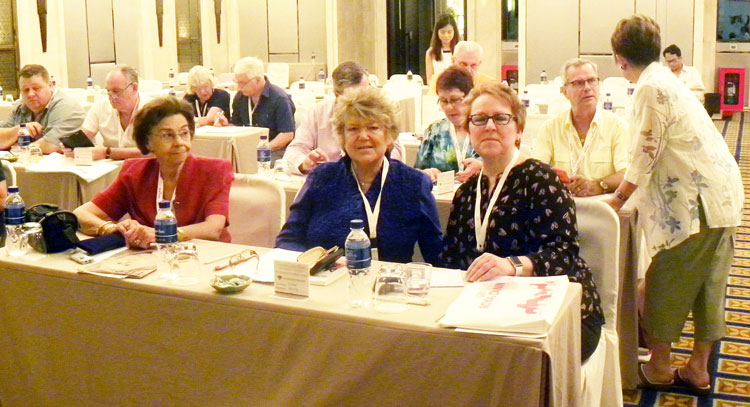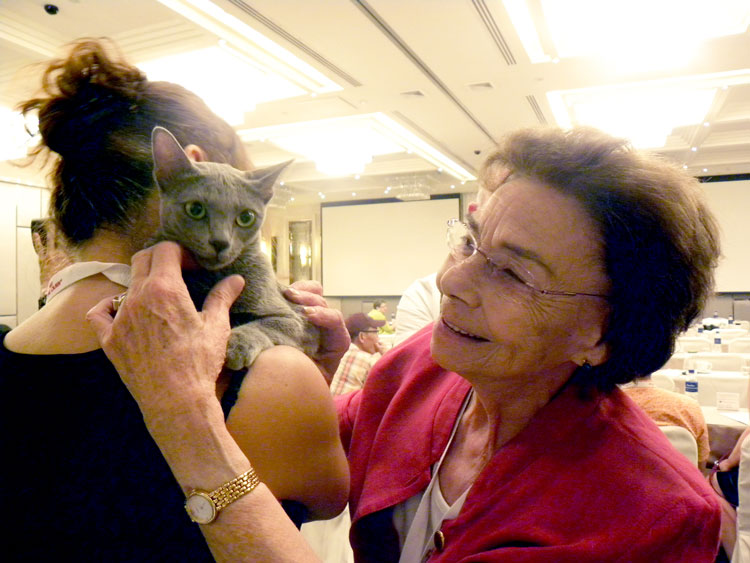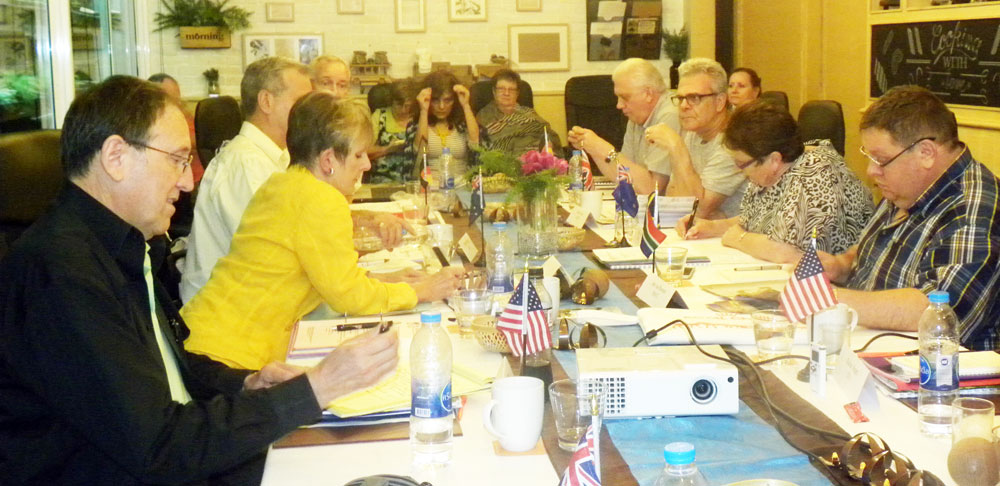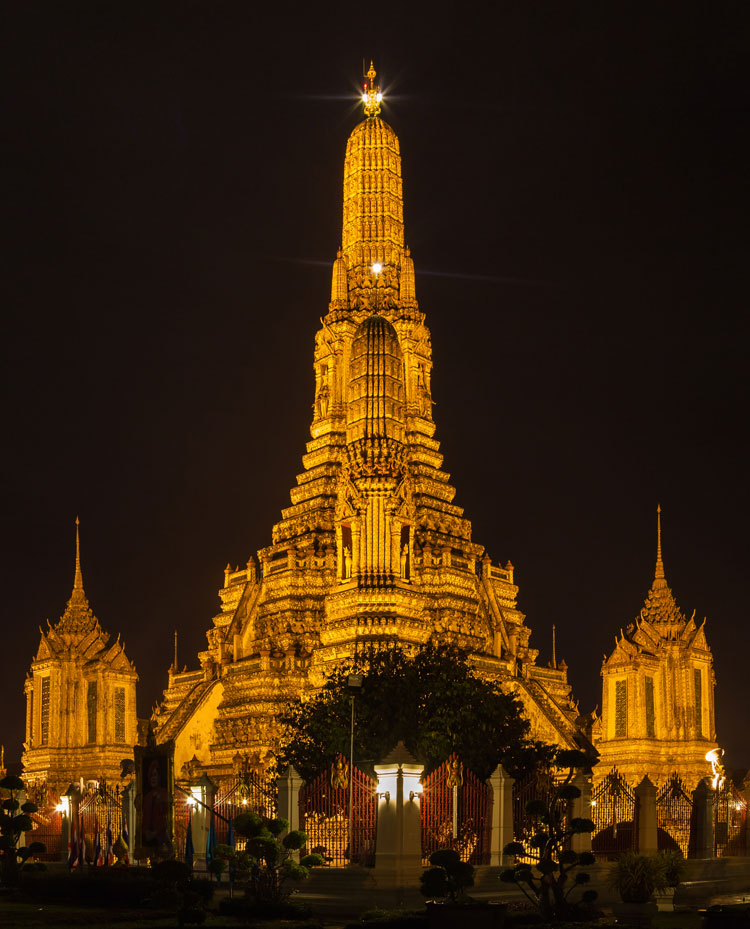
Back row from left to right: Dietmar Sagurski (FIFe), Steve Crow (GCCF), Eric Reijers (FIFe & WCC President), Fate Mays (TICA).
Middle row from left to right:Robbie Walker (ACF), Jan van Rooyen (SACC), Cheryle U'Ren (CCCA & WCC Vice-President), Chris Lowe (NZCF), Rachel Anger (CFA), Andreas Mobius (WCF).
Front row from left to right: Lesley Morgan (ACF), Penny Bydlinski (WCC Secretary/Treasurer), Anneliese Hackmann (WCF).
This year’s annual meeting took place in Thailand’s exotic city of Bangkok. It was hosted by The Cat Society of Thailand, which is a sub-club of a German affiliate of the World Cat Federation. The delegates were given a warm welcome by the club members who, amongst other things, had organised a trip to the ancient and beautiful Grand Palace, together with Wat Phra-Kaew. Although It was packed with tourists and extremely hot, it gave an insight into the culture of Thailand with its amazing art and architecture.
.The Seminar took place on Friday in the luxurious setting of the Grande Centre Point Hotel. It was a splendid room, very fully equipped with two huge screens. Thai translators were doing a hard and efficient job of translating all of the proceedings, which took place in English. Refreshments were almost permanently available in the anteroom and the whole thing ran very smoothly.
The Seminar was opened by Andreas Möbius, the Secretary of the WCF, on behalf of the Thai club. The first speaker was Mrs Penny Bydlinski, the Secretary/Treasurer of the World Cat Congress. Mrs Bydlinski gave a PowerPoint presentation of the history of the WCC. This illustrated the beginning and growth of the Congress. The presentation allowed for the delegates to introduce their member organisations at the point in the presentation when that organization had joined the Council.

Laureline Malineau addressing the Seminar
The next speaker was Laureline Malineau , the representative of Royal Canin, who in the meantime is very well known to WCC Members since she has attended most of the annual meetings for some years. She spoke of the shared passion for cats and how interesting it was to meet breeders from all over the world. She then showed an interesting and enjoyable film illustrating the work of Royal Canin. She remarked on the fact that the WCC Secretary had said that the WCC was very thankful for the partnership with Royal Canin and she wanted to add that Royal Canin was also very thankful for this partnership, which had been in existence for ten years. She said it was a logical partnership as both parties shared the same object, which was to promote the health and welfare of cats and the cat fancy throughout the world.
She explained that the partnership was not just about sponsorship, it was a co-operation on projects and she spoke of the current project, which was a Cat Encyclopeaedia. She then showed examples of pages from the Encyclopaedia. It was aimed at both breeders and future owners of a cat, with emphasis on responsible ownership. She ended by saying that Royal Canin was very happy to be collaborating with the WCC on such an interesting project.
This was followed with Svetlana Lalovic’s presentation entitled “Siamese, Wichianmaat, Korat, Suphalak and other breeds with origin in Asia.” This presentation was very well illustrated with pictures from ancient scrolls as well as photos from the early days of the cat fancy in the West. She spoke about the old Thai breeds and the history associated with them. Speaking of the introduction of the most well known of these breeds, the Siamese, she talked about their early introduction to Europe and their subsequent popularity throughout the world, citing some old writings from authors such as Harrison Weir and Frances Simpson.
She illustrated the physical changes to the appearance of the Siamese and moved into the present day when some breeders had wanted to preserve the original look of the Thai cat. This had led to the creation of the “Thai“ cat that is being bred today and is recognized by WCF, TICA and, provisionally, by FIFe. She pointed out that although the standards differed in small points, they were based on the Wichianmaat; the native cat of Thailand.
She spoke about the ancient manuscript known as the Samut Khoi, parts of which were 600 years old. These were an illustrated collection of poems about the various cats of Thailand, extolling their virtues or their drawbacks. She showed these pictures and spoke about the individual colour varieties.
Some Thai cats had been brought along and everybody found these very interesting. Among them was a Khao Manee, a Wichienmaat, a Korat, and a Suphalak.
Lunch was provided by Royal Canin in an elegant room of the hotel. It was extremely good and added to the relaxed and pleasant atmosphere of the whole day.
Following lunch the Seminar resumed with Dr Janlirn Phavaphutanon, a Thai veterinarian. Her subject was “Management: what the breeder needs to know.” This was an extremely interesting and in-depth discourse of many aspects of cat breeding. The very full description of the reproductive cycle of the cat was well explained and led into further information covering normal and abnormal situations, which the breeder needed to understand.
Next came the ever-popular Prof. Dr. Leslie Lyons, who has spoken at several WCC Seminars during the years and whose support is highly valued. She was visiting Thailand for the first time and said she was happy to be there and to meet the local cat breeders. She thanked Royal Canin, who fed the cats at the University of Missouri and whose involvement in the cat fancy she appreciated. Together with the Winn Foundation, they had been partners for a long period of time. She spoke of the need for funding with their heritable disease projects. She also mentioned the on-going “99 Lives” project to which WCC had made a donation the previous year. She was grateful for the donations but stressed that it was a lengthy process adding that not only one mutation would produce certain conditions and this was a complex matter.
The Scottish Fold mutation had now been published together with a team in Australia. The spasticity work is published, which was together with Dr Richard Malik in Australia and various other breeders. The cats that were sequenced for that project had just come from Italy and there was concern in Europe as it was a new active disease. The Persian PRA project had been accepted and published. She had previously mentioned the blood type AB, which was very rare and found only in Ragdolls; that work had also been published. The Bengal cat project had gone ahead and they had started testing cats with Bengal blindness and that was now fixed. The Japanese Bobtail mutation had been found and, new on the list, was russet Burmese. There is also a new approach called ‘precision medicine’, which she would talk about.

Delegates at the Seminar
She displayed a chart showing the various projects and added that a paper was coming out from other specialists who were working on the ticked pattern, the dilute modifier and the inhibitor genes. She referred to the charcoal colour in Bengal cats, which, she explained, was because they had one copy of the domestic cat allele and one of the Asian Leopard cat wild type allele. With these cats it can be seen that they are retaining some of the alleles from the wild cat. One of her students had done a study in which they typed 100 Asian Leopard cats and established that 100% of them had wildcat dna. The study had been made on cats, which had been bred under controlled conditions, and they knew the generation. In F1 cats it was 47%. An F1 bred back to a domestic gave 24.5%. In this way they could establish that their tests were accurate. They then took a random selection from their database of cats, which were registered as Bengals and were the result of different breeding programmes. These cats included up to F7 generations and the result was that 7% had the Asian Leopard cat allele, regardless of generation. She explained that this was because breeders were selecting for attributes of the Asian Leopard cat and because of that selection it was believed that the resultant Bengals retained 6 or 7% of the Asian Leopard alleles.
Dr Lyons continued with colours, reminding the audience that the cat’s hair is banded and there are two main different colours; eumelanin and phaemelanin. In recent years the Amber modifier has been identified in the cat. This indication was a major colour focus in horses and dogs but was not present in cats; it is very rare and appears only in Norwegian Forest Cats. They had received samples of the russet Burmese. With reference to the ability to identify the mutation that caused the Amber modifier, they were able to test these samples and found it to be a similar mutation. It was a real colour. When they carry out these tests, they test about 200 different cats; ten cats from each breed and about the same number from a random bred population. The only place they had found this mutation was in Burmese from Australia and New Zealand; they will be examining it further in the future.
She then went on to explain that a series of tests for mutations which altered colour had led to the possibility that there could be more than one type of silver; they would be doing further work on the silver gene in the future.
They were still looking for the mutation that caused hydrocephalus cats; originating in Orientals from Europe. The affected cats were otherwise normal but the mounting fluid caused a deterioration of the brain.
The mutation for lymphoma in British Shorthairs had been found and published. It was a recessive trait and tests were available.
Speaking of the Retinal Atrophy mutation, found mainly in Abyssinians as they had two of these mutations, she pointed out that not all affected cats would show symptoms so breeders needed to be aware of this and test their cats.
The Persian blindness had now been published. It had been identified in cats also in Europe and was probably more widespread than was known.
There are now four retinal degeneration tests. She spoke at length about retinal degeneration and explained how it had also been identified in wild cats, specifically the African Black footed cat. Also, in work with Pallas cats. Polycystic Kidney Disease had been identified in those cats.
The Japanese Bobtail had no health problems; their tail was kinked because of the heavy vertebrae and they also tend to be missing one of the thoracic vertebrae but this caused no health problems. The Pixie Bob had either the Manx mutation or the Japanese Bobtail mutation. The Kurilian Bobtail was the same mutation as the Japanese. The American Bobtail was a different mutation and it was not known what it was. Bobcats were also tested and they also did not have the mutation.
Unlike dogs, Orthopedics were not something relevant to cats, but as there was a student interested in that field they had decided to characterize dwarfism. They wanted to know if cats had the same symptoms, such as disc probems, seen in Dachshunds. They studied a range of cats with different lengths of bone. So far they had established that the dwarf cats were very different from normal cats but did not appear to have any problems.
Part of their work was concerned with individual cats showing unexplained conditions; this involved sequencing the cat concerned and also looking at its parents and siblings.
At this point she reverted to the term ‘precision medicine,’ which had been around for some time but was given official backing in President Obama’s speech to the Union the previous year. It meant basically the use of genetics to identify and take account of an individual’s genetic variability in a specific case. The 99 Lives project had adopted this approach with a cat from Illinois, which was diagnosed as having a Lysosomal storage disease of an unknown type. As this was a kitten, the condition had to be genetic. They sequenced the cat and on analysing the results they found a homozygous mutation in a gene that showed a new mutation for Lysosomal Storage disease.
The Lykoi, LaPerm and Peterbald had been sequenced, as had the Munchkin and American Curl.
Speaking of other conditions that they would like to investigate, Dr Lyons said that she needed a Burmese with diabetes and felt sure that one could be found, particularly in the UK.
She was asked about whether the Amyloidosis in Abyssinians was the same as that in Siamese. She replied that she was treating it as a different form until they knew positively; it could be different mutations of the same gene or it might be different genes. The presentation was different and it was not known whether it was a dominant or recessive trait.
Dr Pederson was still working on FIP. He had some positive results with a protease inhibitor and was doing trials. It was not working 100% but there was a marked improvement on previous efforts.
She spoke about genetic testing for taste receptors in humans. Individual areas could be identified as liking bitterness, sweetness etc. She explained that if humans had these receptors, cats would also have them. Pet food companies were realizing that and were adjusting food for the preference of individual cats. From the 99 Lives database Dr Lyons would be able to see if there were any variations in the genes concerned.
Dr Lyons showed a map marking where cats had come from and pointed out that one of the gaps was in Russia. She found it interesting that many different colour variations were now coming from Eastern Europe and Russia, possibly because they had not been seen in the past. She showed the racial populations of cats, which she had shown before, and said it could now be narrowed down to about ten different racial populations.
They had extended the breeds examined to about 30 breeds by including the Selkirk Rex and also European Shorthairs.
Dr Lyons had been to Madagascar and reported on the cats there. She reported that the island had a French history and lay about 280 miles off the coast of Africa. She had wanted to know where the cats had come from. She had wondered whether they had been there before Madagascar split from Africa or whether they had come from dispersal. She spoke of the Fossa, which was the closest carnivore to the cat on the island. Various peoples from Asia had moved to the island over the centuries and the Portuguese and French had arrived as late as the 16th C. The explanation had been surprising. She then referred to the population table, where she could demonstrate that genetic matches were predominantly with India. The conclusion was that the cats were there on Madagascar long before any European colonisation. In fact Madagascar had been attached to India for longer that it had been attached to Africa; together with India it had separated about 135 million years previously, at about the time mammals were starting to emerge, but it had remained connected to India and had only separate from it about 55 million years later.
After the break the last speaker was Dr Kaywalee Chatdarong, whose subject was entitled “Get to Know FeV and FIP intervention,”
This speaker gave a very thorough description of the viruses involved and their effects. She explained the courses of the two diseases and the need for good cattery management in both cases. She had chosen these two viruses because they were complicated. She spoke about the existing tests and things, such as false negative, that were necessary to know about such tests. She also advised on what to do when a cat was positive for either of these diseases.

Penny Bydlinski examining a Korat
That evening the delegates and judges were taken on a dinner cruise down the river Chao Phraya. This was very relaxing with a cool breeze, which was extremely welcome after the heat of the day. The buffet food was also good and there was music being played on the lower level. Viewing the various illuminated buildings from the river was both enjoyable and interesting.
A WCF World show took place during the next two days. Some of the delegates were judging on one of the two days and those who were not, were able to see a little more of Bangkok. Those who judged found the exhibitors to be charming and, although inexperienced, were very gentle with their cats. On Saturday evening all were invited to dinner at a delightful outdoor restaurant. The guests were entertained by Thai dancers before having an extremely good dinner accompanied by very generous servings of wine.
The Business meeting of the WCC took place on Monday and the Minutes are available for download.

Delegates at work

Australian judge Marion Cooper who attended the WCC and stayed to enjoy the tigers
The weekend had been enjoyed by all who attended and, once again, the value of meeting with delegates from other organisations and discussing points of general interest was appreciated.
Some of those attending staying a few days longer to see more of Thailand and the highlight for them was a visit to the Tiger Temple, where they had the opportunity to come up close and even touch the magnificent animals as they relaxed in the heat of the afternoon.
The Minutes of the meeting are available for download.





